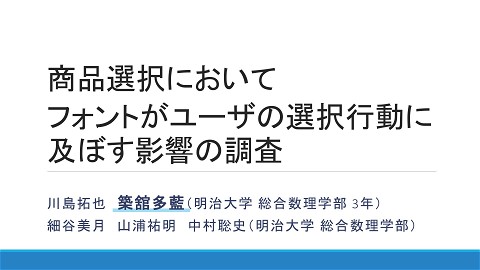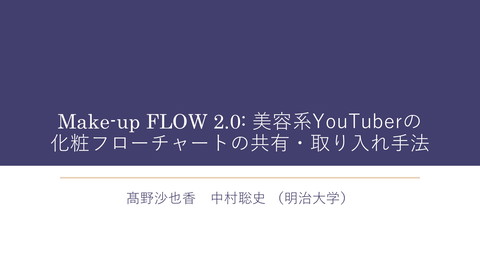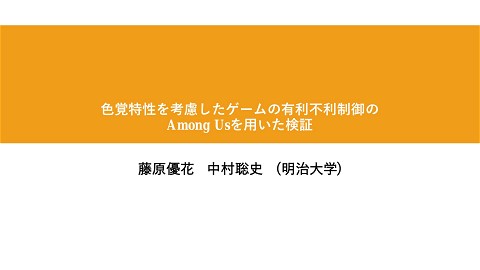Glasses Encourage Your Choices: A System that Supports Indecisive Choosers by Eye-tracking
336 Views
August 02, 23
スライド概要
There is the problem of worrying when making a choice. To solve this problem, we propose a system that recommends products like a clerk in a store when in need. In this study, we focus on the fact that people tend to gaze at what they are interested in. Our system observes eye movement during selection and encourages selection by suggesting to a person who is having difficulty choosing that they select the product they have been looking at most. We developed a prototype system that implements the proposed method using a wearable eye-tracking system. We conducted two selection experiments, a selection from a menu (number of options: N=20) and a selection from a catalog (N=116), to test the system's usefulness. As a result, the selection from a menu reduced the time required for selection and resulted in high selector satisfaction. There was no such tendency in the case of selection from a catalog. Gaze movements during selection were more complex than in the selection from a menu, suggesting that the timing of recommendation may be necessary.
明治大学 総合数理学部 先端メディアサイエンス学科 中村聡史研究室
関連スライド
各ページのテキスト
Glasses Encourage Your Choices A System that Supports Indecisive Choosers by Eye-tracking Tatsuya Komatsubara, Satoshi Nakamura Meiji University
Overview 1 We realized a wearable recommendation system that suggests a choice based on the user’s eye movements while selecting We conducted two experimental tests and our system effective in the short selection Recommendation
Background: Indecisive Personality People should make various choices in their daily lives. ex) souvenir, food, visiting place, career path Indecisive Personality It is not easy for people to decide a choice from options. → They feel anxiety caused by imagining regret after making choice. 2
Background: Indecisive Personality • They missed an opportunity to purchase during a limited-time sale. • They irritated friends by agonizing over the fast-food menu item. • Indecisive chooser feel more tired in select and reduce satisfaction with the final choice *1 People who have indecisive personalities hope to be supported in some way *1 Rassin, E. and Muris, P.. Indecisiveness and the interpretation of ambiguous situations. Personality and Individual Differences, 2005, vol. 39, no. 7, pp. 1285-1291. 3
Advice from others 4 Other's advice enables indecisive choosers to decide Where to go in Denmark L How to support decision-making?
Advice from others 5 Other's advice enables indecisive choosers to decide Friend “I recommend” OK How to support decision-making?
Related work Indecisive people look closely at their options [2]. The decided option was the most gazed one in the options 6 [3]. Is it beneficial for indecisive people to be recommended the option they look at the most among the all options? [2] Patalano, A. L., Juhasz, B. J. and Dicke, J.. The relationship between indecisiveness and eye movement patterns in a decision making informational search task. Journal of Behavioral decision making, 2009, vol. 23, no. 4, pp.353-368. [3] Shimojo, S., Simion, C., Shimojo, E. and Scheier, C.. Gaze bias both reflects and influences preference. Nature Neuroscience 6, 2013, pp. 1317-1322.
Proposed method 7 Our method continuously monitors what the user looks at and recommends the most looked one if the user becomes indecisive Glasses “I recommend” OK
Prototype System Our prototype system assesses what the user looks at by using a wearable eye-tracking system and an image recognition system It recommends most looked option when user thinks longer 8
Wearable eye-tracking system Eye-tracking while selecting by Tobii Pro Glasses 3 Scene camera Eye camera 9
Monitoring what the user gaze 10
Image recognition Our system compares an image captured by a scene camera with learned images by using Teachable Machine Count how many times each option is recognized 11
Real-time recognition 12
Experiment: Hypothesis & Flow Hypothesis Recommending the most looked option encourages users to decide Testing hypothesis through experimentation Our Method Instruction Start & Selecting Recommend Decision Questionnaire Decision Questionnaire Baseline Instruction Start & Selecting 13
Two Experiments Experiment I 20 options' menu in 3 categories 14 Experiment II 102 options in booklet catalog
Result: Experiment I 15 Successful group : Participants selected recommended option Unsuccessful group: Participants didn’t select recommended option Error group : Participants recommended other option by error Number of people Selection time(s) Satisfaction (1 to 5) Total 21 75.14 4.19 Successful 6 71.50 4.67 Unsuccessful 7 79.25 3.88 Error 8 73.57 4.14
Result: Experiment I 16 Successful group:Selected recommended option Unsuccessful group:Didn’t select recommended option Error group:Recommended other option by error Number of people Recommend most Total option 21 viewed Selection Satisfaction Shortens time(s) selection (1 to time 5) 75.14 4.19 Increases satisfaction 71.50 4.67 Successful 6 Unsuccessful 7 79.25 3.88 Error 8 73.57 4.14
Result: Experiment II 14 participants used system / 11 participants didn’t System was not generally effective on Experiment II situation 17
Why system was not effective on Experiment II ? What the user was looking at and when horizontal axis -elapsed time vertical axis -viewed page number 18
Why system was not effective on Experiment II ? viewed in page order viewed only several options 19
Why system was not effective on Experiment II ? Search behavior was interrupted by recommendation 20
Why system was not effective on Experiment II ? reason 1 Search behavior was interrupted by recommendation Timing of the recommendation was not match for some participants 21
Why system was not effective on Experiment II ? Advice should be given when the user has a grasp of the candidates and is narrowing down the list to a few 22
Why system was not effective on Experiment II ? 2:Recommend most viewed object was not good for selecting an option in Experiment II There are some unusual things in catalog He interested in it If they gaze at options in carefully our system recognized that it gazes in their interested How is this made? 23
Why system was not effective on Experiment II ? There are some unusual things in catalog reason 2 He interested in it If they gaze at options in carefully Recommend most viewed object was not our system recognized that it gazes their interested good forin selecting an option in Experiment II How is this made? 24
Discussion 25 Our system is effective on situation like Experiment I There are many situations to choose →not currently capable of handling all of situation We aim to improve for a variety of situations Next page: How to solve these problems→
Discussion 1:Timing of the recommendation was not match for some participant →Automatically estimate when to recommend based on gaze data →A mechanism for users to tell the system when they want a recommendation 2:Recommend most viewed object was not good for selecting an option in Experiment II →Adding a time series component to the interest assessment will allow us to focus more on the selector's interest 26
Summary Purpose Indecision makes many losses →Indecisive people need to overcome it Result In situation selecting from menu Recommendation made their select shorten and satisfying 27 System Recommend option what user most looked at Discussion Recommendation isn’t effective in every situation Change algorhythm





